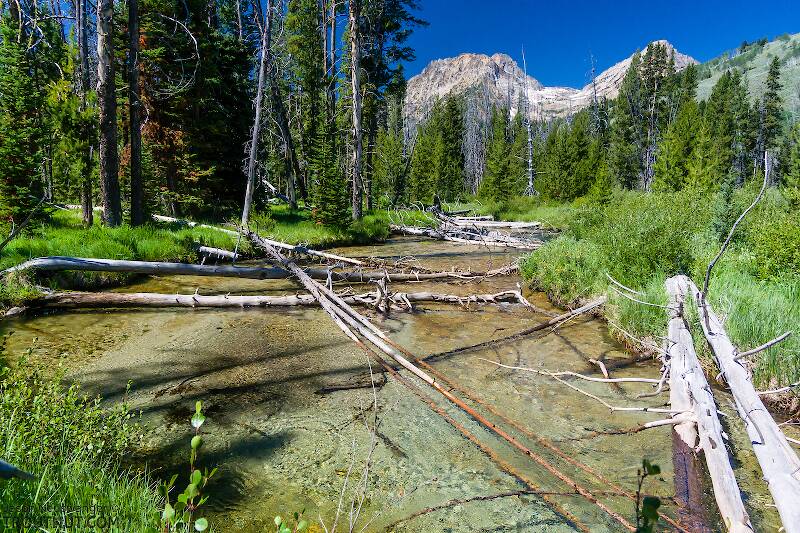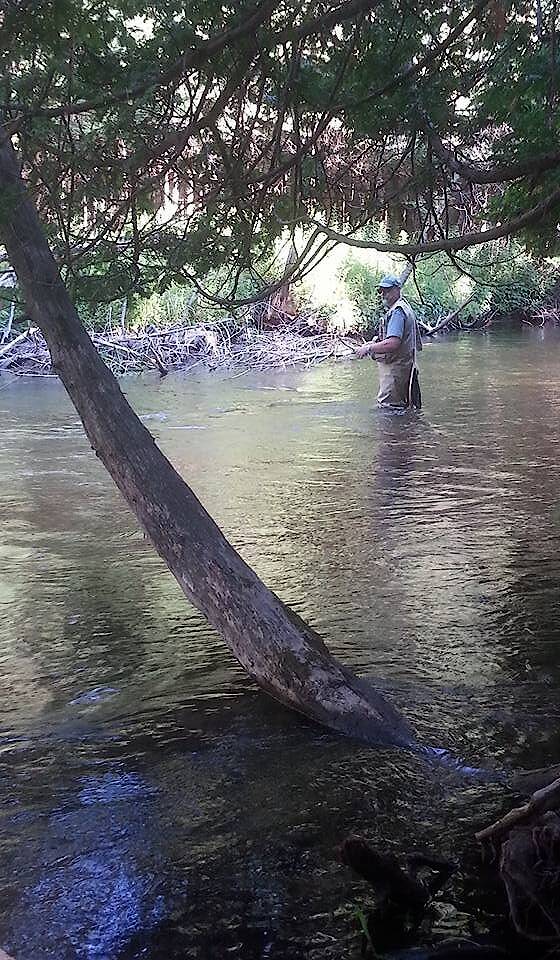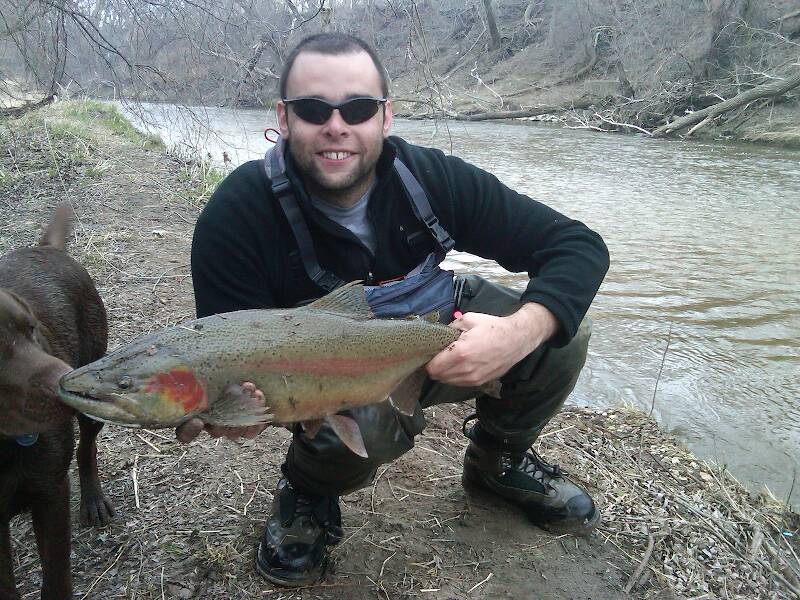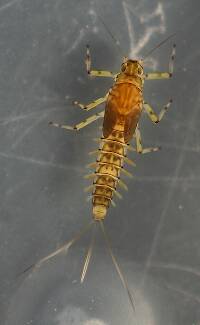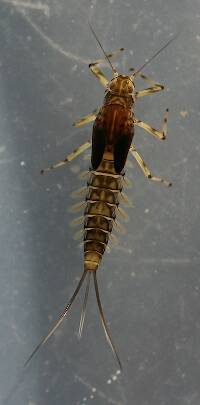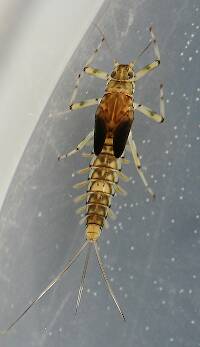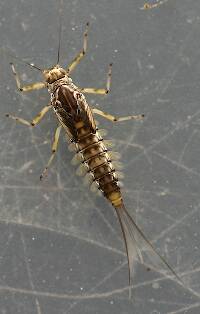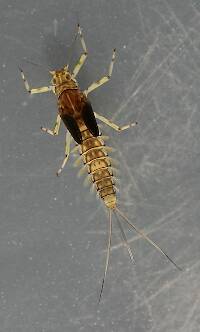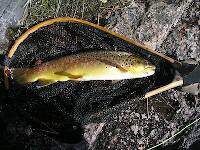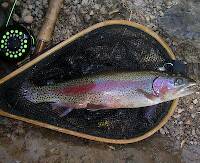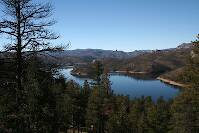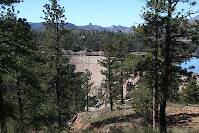
Hex Mayflies
Hexagenia limbata
The famous nocturnal Hex hatch of the Midwest (and a few other lucky locations) stirs to the surface mythically large brown trout that only touch streamers for the rest of the year.
Featured on the forum

I was not fishing, but happened to be at an unrelated social event on a hill above this tiny creek (which I never even saw) when this stonefly flew by me. I assume it came from there. Some key characteristics are tricky to follow, but process of elimination ultimately led me to Sweltsa borealis. It is reassuringly similar to this specimen posted by Bob Newell years ago. It is also so strikingly similar to this nymph from the same river system that I'm comfortable identifying that nymph from this adult. I was especially pleased with the closeup photo of four mites parasitizing this one.

Troutnut is a project started in 2003 by salmonid ecologist Jason "Troutnut" Neuswanger to help anglers and
fly tyers unabashedly embrace the entomological side of the sport. Learn more about Troutnut or
support the project for an enhanced experience here.
Feathers5
Posts: 287
Posts: 287
Feathers5 on Aug 21, 2014August 21st, 2014, 7:20 am EDT
I read an article that said the Fall BWO nymph should be fished on or near the surface. Fishing it deep is futile. The piece continued that fish only eat these nymphs as they approach the surface. Anybody care to go with this and enlighten me? This hatch intrigues me. I had a few real good days last year during this emergence, but all on the surface.
Thanks,
Bruce
Thanks,
Bruce
TNEAL on Aug 21, 2014August 21st, 2014, 12:04 pm EDT
I spent many years fishing the Fall olive hatch here in Michigan almost exclusively with nymphs. They were far more effective than dries unless the air temps were cold enough to prevent the duns from getting off the water. I fished them upstream to rising trout as well as down and across; never very deep but often under motion. I'm not sure about the on or near the surface idea but I never fished them very deep.
Tim
Tim
Millcreek on Aug 25, 2014August 25th, 2014, 6:16 am EDT
Bruce-
Not much of a flyfisherman but from what I've seen of Baetis nymphs they're probably not much of a target for trout when they're on the bottom.
I'd think trout would tend to feed on them when they're part of the drift or when they're molting. The drift would probably be in the top half of the water column and molting nymphs (either between instars or emerging) would be more towards the top.
Mark
Not much of a flyfisherman but from what I've seen of Baetis nymphs they're probably not much of a target for trout when they're on the bottom.
I'd think trout would tend to feed on them when they're part of the drift or when they're molting. The drift would probably be in the top half of the water column and molting nymphs (either between instars or emerging) would be more towards the top.
Mark
"If we knew what it was we were doing, it would not be called research, would it?"
-Albert Einstein
-Albert Einstein
Roguerat on Aug 25, 2014August 25th, 2014, 8:33 am EDT
For Fall fishing on smaller streams (in SW Michigan) I get the most hits and/or hookups with BWO emerger patterns, 18's and 20's. I'm not sure why, they just seem to work when deep nymphs or dries on the surface aren't doing squat. TNEAL and Millcreek's answers makes a lot of sense, in retrospect. A nymph fished shallow and on the drift vs. deep 'knocking the rocks' sounds like a winner. Gonna' try this next time out.
Roguerat
I Peter 5:7 'Cast your cares upon Him..'
Roguerat
I Peter 5:7 'Cast your cares upon Him..'
TNEAL on Aug 25, 2014August 25th, 2014, 12:26 pm EDT
Our Fall olives are very small; nearly trico size. I started out fishing #22 nymphs and gradually increased the size all the way up to #18 with no drop off in success. Hope this helps.
Wbranch on Aug 25, 2014August 25th, 2014, 6:11 pm EDT
What's an "instar"?
Catskill fly fisher for fifty-five years.
Millcreek on Aug 25, 2014August 25th, 2014, 6:26 pm EDT
What's an "instar"?
It's the stage of an insect's life between molts (shedding it's exoskeleton).
"If we knew what it was we were doing, it would not be called research, would it?"
-Albert Einstein
-Albert Einstein
Wbranch on Aug 25, 2014August 25th, 2014, 6:42 pm EDT
Thanks! So I'm assuming different mayfly species have more or less instars than others? Do bigger mayflies, like Ep guttalata or simulans have more? If so about how many?
Catskill fly fisher for fifty-five years.
Martinlf on Aug 25, 2014August 25th, 2014, 8:23 pm EDT
Interesting discussion. Thanks for the question, Bruce. I'm not fishing now, but hope to get back on the water in a few weeks and will give some shallow nymphs a try.
"He spread them a yard and a half. 'And every one that got away is this big.'"
--Fred Chappell
--Fred Chappell
Millcreek on Aug 25, 2014August 25th, 2014, 8:28 pm EDT
Thanks! So I'm assuming different mayfly species have more or less instars than others? Do bigger mayflies, like Ep guttalata or simulans have more? If so about how many?
I'm not sure how much work has been done on the number of instars different species of Ephemeroptera go through. All the information I've been able to find is pretty general and says the nymphs can go through 12-45 instars but most go through about 15-25. I don't know if the size of the nymphs affects the number of instars they go through. Entoman or Taxon may know more if they pick up on this thread. Sorry I can't offer more information on this.
"If we knew what it was we were doing, it would not be called research, would it?"
-Albert Einstein
-Albert Einstein
Taxon on Aug 25, 2014August 25th, 2014, 9:24 pm EDT
Hi Matt-
It's my understanding that number of nymphal instars a mayfly undergoes may vary from perhaps 10 to 30 or more, depending on species, water temperature, and other environmental factors.
It's my understanding that number of nymphal instars a mayfly undergoes may vary from perhaps 10 to 30 or more, depending on species, water temperature, and other environmental factors.
Crepuscular on Aug 26, 2014August 26th, 2014, 4:47 am EDT
I read an article that said the Fall BWO nymph should be fished on or near the surface. Fishing it deep is futile.
Stop reading and go fishing. Then you can write the article on what works or doesn't work for you in a particular situation. You even said you had good fishing. What exactly are you looking for? If you want to fish BWO nymphs deep fish em deep. If you catch fish it's not futile, if you don't catch any there may not be any fish there. I can assure you that whoever wrote that article has not experienced every fall BWO emergence on every stream that you fish. You know how to catch fish, don't muck it up with preconcieved notions of what the bugs and trout are "supposed to be doing" both the mayflies and the fish have not read the articles.
Feathers5
Posts: 287
Posts: 287
Feathers5 on Aug 26, 2014August 26th, 2014, 5:34 am EDT
I read an article that said the Fall BWO nymph should be fished on or near the surface. Fishing it deep is futile.
Stop reading and go fishing. Then you can write the article on what works or doesn't work for you in a particular situation. You even said you had good fishing. What exactly are you looking for? If you want to fish BWO nymphs deep fish em deep. If you catch fish it's not futile, if you don't catch any there may not be any fish there. I can assure you that whoever wrote that article has not experienced every fall BWO emergence on every stream that you fish. You know how to catch fish, don't muck it up with preconcieved notions of what the bugs and trout are "supposed to be doing" both the mayflies and the fish have not read the articles.
Geez, Eric. I just wanted to generate a discussion. It's something I never realized and I doubt many people do. Did you ever get your a-- kicked by a 60-year-old? Ha! Ha!
Crepuscular on Aug 26, 2014August 26th, 2014, 7:27 am EDT
It's something I never realized and I doubt many people do. Did you ever get your a-- kicked by a 60-year-old? Ha! Ha!
You never realized what?
Oh and no I don't want to either, it would be embarassing.
Feathers5
Posts: 287
Posts: 287
Feathers5 on Aug 26, 2014August 26th, 2014, 10:45 am EDT
I didn't realize it's better to fish the nymphs up in the water column.
Crepuscular on Aug 26, 2014August 26th, 2014, 12:23 pm EDT
I didn't realize it's better to fish the nymphs up in the water column.
Is it? That's my point. The author may have had success fishing them that way, and so have I, but I have caught fish fishing them deep as well, and so have you I bet. As soon as you adhere to generalizations about insect and fish behavior, you are setting yourself up for failure. Is it good to have a full bag of tricks to make the right presentation at the right time, absolutely, but to discount a tactic because some guy said it was futile in a magazine article seems limiting to me. Like I said in my previous post, that author has not fished every fall BWO emergence in the streams you fish so how can he say that fishing a BWO nymph lower in the water column is futile for you? I'm just trying to keep things in perspective.
Kschaefer3 on Aug 26, 2014August 26th, 2014, 1:00 pm EDT
Great point, Eric. One that I could use to keep in mind more often. It's so easy to fall into only doing what the "experts" tell you to do. If what "should" be working isn't, why not try something that "shouldn't" work? It's amazing how many times those "shouldn'ts" actually do work.
Wiflyfisher on Aug 26, 2014August 26th, 2014, 2:38 pm EDT
I am heading to YNP in a short while and hope to hit some awesome BWO hatches. I have been tying BWO Comparaduns, BWO floating nymphs, BWO cripples and Sawyer's original PT nymphs in size #20/#18, as well as some soft hackles. I figure the trout will tell me what stinks and hopefully what they like. :-)
I take all FF articles with a grain of salt and forum posts including my own stuff. :-) The trout never seem to read the same stuff we do.
BTW, I have found several nymphs in their instar stage and they were not in the drift, although it is possible. They were always underneath a rock on the bottom of the river hiding while they went through their molt. See a pic I took... http://flypatternsfortrout.com/2012/04/14/are-mayfly-nymphs-white-between-instar-stages/

I take all FF articles with a grain of salt and forum posts including my own stuff. :-) The trout never seem to read the same stuff we do.
BTW, I have found several nymphs in their instar stage and they were not in the drift, although it is possible. They were always underneath a rock on the bottom of the river hiding while they went through their molt. See a pic I took... http://flypatternsfortrout.com/2012/04/14/are-mayfly-nymphs-white-between-instar-stages/

John S.
https://WiFlyFisher.com
https://WiFlyFisher.com
Oldredbarn on Aug 26, 2014August 26th, 2014, 3:05 pm EDT
Bruce...You're awful cranky these days! What's up...Give Tony a call and he'll send you a dozen or two. :)
I'm sorry that I haven't been here to lend a hand, man, but have been busy with niece and nephew and their college...So busy in fact I haven't been able to compose my fishing report for the Bighorn River at the beginning of this month.
Tim wrote...
and then he wrote you again...
Now I know you don't know Mr Neal, but if you think anything of your old Michigan friend Spence, he would advise you to pay attention to what Mr Neal says. He has logged real angling hours and has tied more flies "than the old Carter has liver pills" saying of old.
What he is alluding to is that there is more than one bug hatching out there that is muddying up things a tad. You will have to be very observant and watch closely to see what the fish are taking...
Here in Michigan, during the "Fall", we can have the little star of another thread, the old Pseudocleon anoka (now Iswaeon anoka) in a good size 24.Then there is the tiny Baetis pygmaeus (now Acerpenna pygmaea) in Tim's 22, though a 24 wouldn't hurt. Then finally the star of Fall, the actual "Fall Baetis" that everyone talks about, but seldom sees...Baetis hiemalis (now Baetis brunneicolor)...(Thank you Roger! :)...The last one here doesn't show until Oct/Nov when most folk are either hunting or moving indoors.
So, sir...What ya going to do? :)
In Tim's case he starts fishing the little guys until B brunneicolor shows later in Oct/Nov and he can be a fair 16. A "big" bug for a Baetis.
You need to do some field work so you know of which "Dink" you speak. :)
It's interesting how the season starts and ends smallish.
I hope this clears things up. ;) Tony? Eric? "Buster want's to fish." :)
Spence
Oh...There is Paraleptophiebia debilis out there too. Size 16/18...You need to pull out your copy of Ann's book I gave you and get to know these critters. Or, believing as Spence does, that size does matter, grab a bug, measure it to hook size, and tie something on that is close enough...
I'm sorry that I haven't been here to lend a hand, man, but have been busy with niece and nephew and their college...So busy in fact I haven't been able to compose my fishing report for the Bighorn River at the beginning of this month.
Tim wrote...
Our Fall olives are very small; nearly trico size. I started out fishing #22 nymphs and gradually increased the size all the way up to #18 with no drop off in success. Hope this helps.
and then he wrote you again...
I spent many years fishing the Fall olive hatch here in Michigan almost exclusively with nymphs. They were far more effective than dries unless the air temps were cold enough to prevent the duns from getting off the water. I fished them upstream to rising trout as well as down and across; never very deep but often under motion. I'm not sure about the on or near the surface idea but I never fished them very deep.
Now I know you don't know Mr Neal, but if you think anything of your old Michigan friend Spence, he would advise you to pay attention to what Mr Neal says. He has logged real angling hours and has tied more flies "than the old Carter has liver pills" saying of old.
What he is alluding to is that there is more than one bug hatching out there that is muddying up things a tad. You will have to be very observant and watch closely to see what the fish are taking...
Here in Michigan, during the "Fall", we can have the little star of another thread, the old Pseudocleon anoka (now Iswaeon anoka) in a good size 24.Then there is the tiny Baetis pygmaeus (now Acerpenna pygmaea) in Tim's 22, though a 24 wouldn't hurt. Then finally the star of Fall, the actual "Fall Baetis" that everyone talks about, but seldom sees...Baetis hiemalis (now Baetis brunneicolor)...(Thank you Roger! :)...The last one here doesn't show until Oct/Nov when most folk are either hunting or moving indoors.
So, sir...What ya going to do? :)
In Tim's case he starts fishing the little guys until B brunneicolor shows later in Oct/Nov and he can be a fair 16. A "big" bug for a Baetis.
You need to do some field work so you know of which "Dink" you speak. :)
It's interesting how the season starts and ends smallish.
I hope this clears things up. ;) Tony? Eric? "Buster want's to fish." :)
Spence
Oh...There is Paraleptophiebia debilis out there too. Size 16/18...You need to pull out your copy of Ann's book I gave you and get to know these critters. Or, believing as Spence does, that size does matter, grab a bug, measure it to hook size, and tie something on that is close enough...
"Even when my best efforts fail it's a satisfying challenge, and that, after all, is the essence of fly fishing." -Chauncy Lively
"Envy not the man who lives beside the river, but the man the river flows through." Joseph T Heywood
"Envy not the man who lives beside the river, but the man the river flows through." Joseph T Heywood
PaulRoberts on Aug 26, 2014August 26th, 2014, 5:19 pm EDT
Bruce, it sounds like you’re wondering what’s known about trout feeding habits on the tiny Baetids? Often when you get no response, your question is too broad, too specific, or you hit on a crevice of this game no one really knows about or has considered much.
I don’t know of any good sources off the top of my head but found a lot of fishing talk when I Googled: Baetis fall trout. But, it’ll probably be a lot about fishing (probably surface and near surface) and not a lot about Baetid and trout behaviors subsurface.
Another place to look is any literature describing stomach contents, and –even better– start doing your own stomach sampling –Baetids flush out nicely with a lavage/“pump”.
I started to write something about fishing tiny nymphs deep in general, but … I’m not sure that’s what you’re after. Here’s what I started…
Whether "selectivity" on the part of the trout is involved is a case by case, possibly even fish by fish, basis. I suspect that such is more likely to happen where there are simply a lot of those Baetids. I've seen that on streams of all sizes, but mostly on vegetated spring creeks, tailwaters, and even some small higher gradient waters too. In many cases, that “selectivity” may have as much to do with myopia than a "search image" thing. I find during some midge/Baetid emergences I can use a Baetid or midge imitation interchangeably, however I may have to decipher which side of the surface film the fish are myopic on: submerged nymph/pupa on very short dropper, floating nymph, or dry.
The reason that tiny flies and surface fishing come together may simply be that the bugs are most vulnerable near the surface. This may be why egg-laying Baetid patterns just haven’t caused a rage. By sheer statistics, they should be. Maybe tiny nymphs are just intimidating to fish subsurface for most fishers? I suppose if it wasn’t for beadheads, few would make use of egg-laying Baetis –whether the possible connection is recognized or not.
I do fish “deep” with tiny nymphs bc Baetids are such a part of the drift much of the year. I also use them in very slow or very laminar flows: calm pool basins, some spring creek channels, calm water along the banks of both large and small rivers -all are places where micro-nymphs (of all types) have worked well for me. This is as much a general response to flat calm water conditions as it is to hatch-matching as I have learned the hard way to ”go small” under high visibility conditions. Of course these waters often produce lots of small bugs so the two go hand in hand, in flyfishing for trout anyway. With some other types of fishing -such as bass fishing- the latter is just not at play, the former is critical.
As to whether we are missing something by not fishing tiny nymphs deeper in fall, (outside of lower clearer water conditions) I can’t say. If you hit a good emergence of fall Baetids (or midges) try it out. I’d suggest paying close attention to finding laminar drift lanes in the right locations for interception of deeper nymphs –probably close to the source: the riffles. I believe most Baetids inhabit the turbulent waters of riffles (EDIT: and in vegetation in slower streams of course). This, in fact, may help keep them safe from trout. I have watched trout glean Baetids from rock tops at pool heads.
Hope this gives you some stuff to chew on.
I don’t know of any good sources off the top of my head but found a lot of fishing talk when I Googled: Baetis fall trout. But, it’ll probably be a lot about fishing (probably surface and near surface) and not a lot about Baetid and trout behaviors subsurface.
Another place to look is any literature describing stomach contents, and –even better– start doing your own stomach sampling –Baetids flush out nicely with a lavage/“pump”.
I started to write something about fishing tiny nymphs deep in general, but … I’m not sure that’s what you’re after. Here’s what I started…
Whether "selectivity" on the part of the trout is involved is a case by case, possibly even fish by fish, basis. I suspect that such is more likely to happen where there are simply a lot of those Baetids. I've seen that on streams of all sizes, but mostly on vegetated spring creeks, tailwaters, and even some small higher gradient waters too. In many cases, that “selectivity” may have as much to do with myopia than a "search image" thing. I find during some midge/Baetid emergences I can use a Baetid or midge imitation interchangeably, however I may have to decipher which side of the surface film the fish are myopic on: submerged nymph/pupa on very short dropper, floating nymph, or dry.
The reason that tiny flies and surface fishing come together may simply be that the bugs are most vulnerable near the surface. This may be why egg-laying Baetid patterns just haven’t caused a rage. By sheer statistics, they should be. Maybe tiny nymphs are just intimidating to fish subsurface for most fishers? I suppose if it wasn’t for beadheads, few would make use of egg-laying Baetis –whether the possible connection is recognized or not.
I do fish “deep” with tiny nymphs bc Baetids are such a part of the drift much of the year. I also use them in very slow or very laminar flows: calm pool basins, some spring creek channels, calm water along the banks of both large and small rivers -all are places where micro-nymphs (of all types) have worked well for me. This is as much a general response to flat calm water conditions as it is to hatch-matching as I have learned the hard way to ”go small” under high visibility conditions. Of course these waters often produce lots of small bugs so the two go hand in hand, in flyfishing for trout anyway. With some other types of fishing -such as bass fishing- the latter is just not at play, the former is critical.
As to whether we are missing something by not fishing tiny nymphs deeper in fall, (outside of lower clearer water conditions) I can’t say. If you hit a good emergence of fall Baetids (or midges) try it out. I’d suggest paying close attention to finding laminar drift lanes in the right locations for interception of deeper nymphs –probably close to the source: the riffles. I believe most Baetids inhabit the turbulent waters of riffles (EDIT: and in vegetation in slower streams of course). This, in fact, may help keep them safe from trout. I have watched trout glean Baetids from rock tops at pool heads.
Hope this gives you some stuff to chew on.
Quick Reply
Related Discussions
Topic
Replies
Last Reply
6
Aug 21, 2010
by Gutcutter
by Gutcutter
0
Jul 2, 2012
by Bjorntofish
by Bjorntofish
10
Sep 3, 2014
by PaulRoberts
by PaulRoberts
2
Apr 6, 2010
by Martinlf
by Martinlf
1
Mar 9, 2012
by Wiflyfisher
by Wiflyfisher

